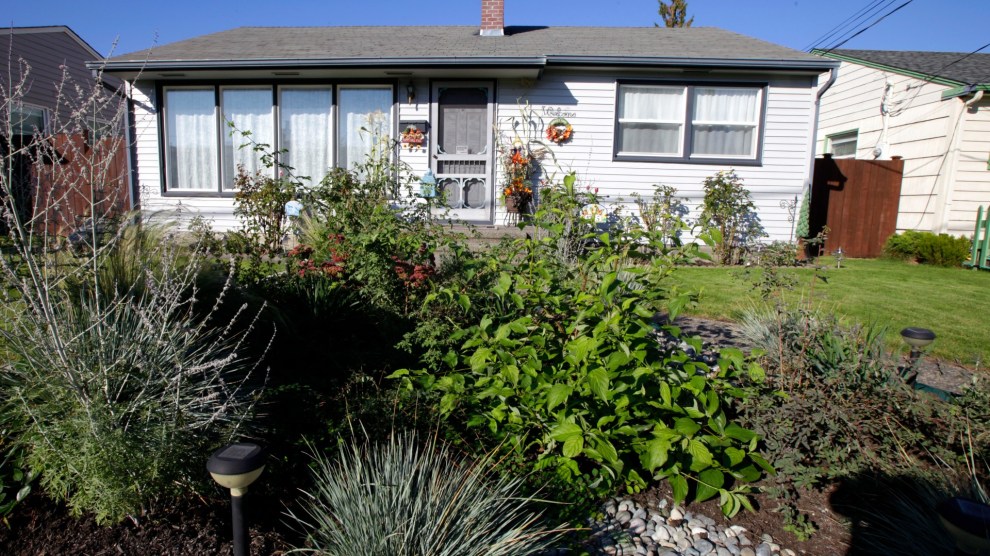
A residential rain garden in Puyallup, WashingtonTed S. Warren/AP
In the last decade or so, a growing number of cities have turned to rain gardens. These shallow, plant-filled ditches can help reduce flooding during storms, which are predicted to get heavier in many parts of the country as the climate changes. Often, rain gardens are part of multi-million-dollar urban development projects. But they can also be part of smaller installations, tucked into a cut in the sidewalk or an open space in your yard.
In addition to helping absorb water, rain gardens can filter dirty street runoff, reduce urban heat, and provide a habitat for pollinators like bees and birds. So if you have space for it, you might consider adding one to your home.
And, depending on where you live, you may not have to pay much, if anything, to install it. The Environmental Protection Agency recommends looking out for reimbursement programs through your local and state public works offices, which can also offer guidance on where to put your garden and what type of foliage to plant.
Here are some more resources to get you started:
The federal government
Check out the EPA’s website for general information about rain gardens, and regional-specific resources for Connecticut, Maine, Massachusetts, New Hampshire, Rhode Island, and Vermont residents. The EPA also links to a community outreach guide if your rain garden ambitions extend beyond your own yard.
There’s an app for that
The University of Connecticut’s Rain Garden App offers a clunky but helpful guide to designing and maintaining a rain garden.
Get schooled
Many academic institutions offer detailed guidance on rain gardens, including Rutgers University, Cornell University, and UMass Amherst.
Local rebate programs
Through a quick internet search, I was able to find green infrastructure rebate programs in many of the United States’ 10 biggest cities:
- New York, New York: The city offers stormwater retention upgrades for properties that are 50,000 sq feet or larger.
- Los Angeles, California: Get rebates for adding native plants and rain-capturing strategies like “swales, rain tanks, or infiltration trenches” to your property.
- Chicago, Illinois: Order free rain barrels!
- Houston, Texas: “Sponge gardens” may qualify for funding and/or tax abatement.
- Phoenix, Arizona: Phoenix doesn’t offer rebate programs, but seven nearby communities—Avondale, Chandler, Glendale, Mesa, Peoria, Scottsdale, and Tempe—do.
- Philadelphia, Pennsylvania: Rain gardens, rain barrels, downspout planters, and permeable pavers may be eligible for funding.
- San Antonio, Texas: Get rebates for replacing your grass lawn, updating your irrigation system, and more.
- San Diego, California: There are many possible rebates in San Diego, including rain gardens, rain-friendly pavement, and turf replacement.
- Dallas, Texas: As far as I can tell, Dallas doesn’t offer rebate programs for green infrastructure but does offer free irrigation system evaluations.
- San Jose, California: The Bay Area Water Supply and Conservation Agency’s website reads, “Replace your lawn with a beautiful, drought-tolerant landscape and receive a rebate of up to $4 per sq. ft. Add a Rain Garden to your project and earn an additional $300 rebate!”
Take an online course
The Rain Garden Network offers a 10-step course for building your own rain garden for $7.99. (I haven’t taken the course myself; I came across it via the American Society of Landscape Architects.)
Look for volunteering opportunities
Even if you don’t have a yard of your own, there may be volunteer opportunities nearby to help care for or install rain gardens in public areas. San Francisco Public Utilities Commission’s Rain Guardians program, for instance, allows residents to adopt and care for rain gardens. Or Friends of the Urban Forest, an SF-based nonprofit, has installed thousands of sidewalk gardens across the city, often with the help of volunteers.
















